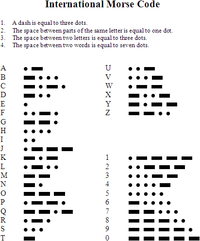Morse code: Difference between revisions
From Halopedia, the Halo wiki
mNo edit summary |
m (Text replacement - "{{[Ee]ra\|[^}\n]*(Forerunner|Covenant|Human|UNSC|HCW|Post)[^}\n]*}}" to "{{Status|Canon}}") |
||
| (13 intermediate revisions by 11 users not shown) | |||
| Line 1: | Line 1: | ||
{{ | {{Status|Canon}} | ||
{{Wikipedia|Morse Code}} | |||
{{ | [[File:International Morse Code.png|thumb|An explanatory diagram of Morse Code.]] | ||
[[ | |||
'''Morse Code''' is a character encoding for transmitting telegraphic information, using standardized sequences of short and long elements to represent the letters, numerals, punctuation and special characters of a given message. The short and long elements can be formed by sounds, marks or pulses, in on off keying and are commonly known as "dots" and "dashes" or "dits" and "dahs". | '''Morse Code''' is a character encoding for transmitting telegraphic information, using standardized sequences of short and long elements to represent the letters, numerals, punctuation and special characters of a given message. The short and long elements can be formed by sounds, marks or pulses, in on off keying and are commonly known as "dots" and "dashes" or "dits" and "dahs". | ||
| Line 15: | Line 14: | ||
Morse code can be transmitted in a number of ways: originally as electrical pulses along a telegraph wire, but also as an audio tone, a radio signal with short and long tones, or as a mechanical or visual signal (e.g. a flashing light) using devices like an Aldis lamp or a heliograph. Morse code is transmitted using just two states (on and off) so it was an early form of a digital code. However, it is technically not binary, as the pause lengths are required to decode the information. | Morse code can be transmitted in a number of ways: originally as electrical pulses along a telegraph wire, but also as an audio tone, a radio signal with short and long tones, or as a mechanical or visual signal (e.g. a flashing light) using devices like an Aldis lamp or a heliograph. Morse code is transmitted using just two states (on and off) so it was an early form of a digital code. However, it is technically not binary, as the pause lengths are required to decode the information. | ||
Morse Code is | Morse Code is still one of many different codes still in use with the [[UNSC]] by at least [[2552]].<ref>'''[[Halo: First Strike]]''', Chapter 16, ''page 156'' (2003 paperback); ''page 192'' (2010 paperback)</ref> When inside [[the Sharpened Shield]], after accidentally killing a [[Huragok]], [[Lucy-B091]] briefly pondered about communicating her apology to its colleague in Morse code.<ref>'''[[Halo: Glasslands]]''', Chapter 5, ''page 123''</ref> | ||
== Trivia == | ==Trivia== | ||
Morse can be heard on a radio on [[High Ground (Level)|High Ground]], spelling out "Frog Blast The Vent Core".<ref>'''[[Halo 3]]''', multiplayer level, ''[[High Ground (Level)]]''</ref> | |||
==List of appearances== | |||
*''[[Halo: First Strike]]'' {{1st}} | |||
*''[[Halo 3]]'' | |||
*''[[Halo: Glasslands]]'' | |||
==Sources== | ==Sources== | ||
{{Ref/Sources}} | |||
[[Category:UNSC | [[Category:UNSC codes]] | ||
Latest revision as of 21:24, March 19, 2022
| There is more information available on this subject at Morse code on the English Wikipedia. |
Morse Code is a character encoding for transmitting telegraphic information, using standardized sequences of short and long elements to represent the letters, numerals, punctuation and special characters of a given message. The short and long elements can be formed by sounds, marks or pulses, in on off keying and are commonly known as "dots" and "dashes" or "dits" and "dahs".
International Morse code is composed of five elements:
- short mark, dot or 'dit' (·) — one unit long
- longer mark, dash or 'dah' (–) — three units long
- intra-character gap (between the dots and dashes within a character) — one unit long
- short gap (between letters) — three units long
- medium gap (between words) — seven units long
Morse code can be transmitted in a number of ways: originally as electrical pulses along a telegraph wire, but also as an audio tone, a radio signal with short and long tones, or as a mechanical or visual signal (e.g. a flashing light) using devices like an Aldis lamp or a heliograph. Morse code is transmitted using just two states (on and off) so it was an early form of a digital code. However, it is technically not binary, as the pause lengths are required to decode the information.
Morse Code is still one of many different codes still in use with the UNSC by at least 2552.[1] When inside the Sharpened Shield, after accidentally killing a Huragok, Lucy-B091 briefly pondered about communicating her apology to its colleague in Morse code.[2]
Trivia[edit]
Morse can be heard on a radio on High Ground, spelling out "Frog Blast The Vent Core".[3]
List of appearances[edit]
- Halo: First Strike (First appearance)
- Halo 3
- Halo: Glasslands
Sources[edit]
- ^ Halo: First Strike, Chapter 16, page 156 (2003 paperback); page 192 (2010 paperback)
- ^ Halo: Glasslands, Chapter 5, page 123
- ^ Halo 3, multiplayer level, High Ground (Level)
